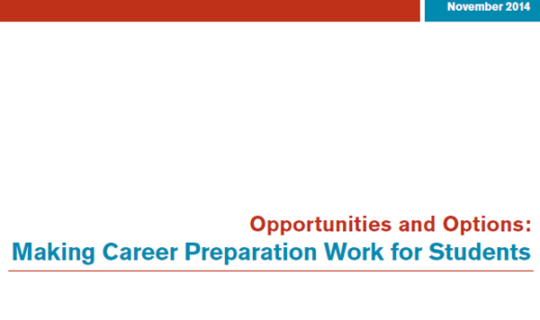Resource: Career Readiness & The Every Student Succeeds Act
Mapping Career Readiness in State ESSA Plans
To achieve success in tomorrow’s workforce, all students need more opportunities to gain college- and career-ready knowledge, skills and experiences while in school, as well as attain some education or training beyond high school. State leaders recognize this shift and are devoting significant attention to increasing the number of high school graduates that are college and career ready.
The Every Student Succeeds Act (ESSA) presented states with a significant opportunity to design their K-12 education systems to prepare all students for college and careers. States used this occasion to set and execute a vision that provides students with multiple, meaningful opportunities to engage in pathways that build awareness of career opportunities, provide real-world instruction and lead to credentials with labor market value. Education Strategy Group and Advance CTE reviewed all state plans to examine and document the extent to which states took advantage of the ESSA opportunity to improve career readiness in grades K-12.
Looking across the 51 state plans, there is no question that more states are planning to leverage ESSA to advance career readiness than in the past, especially through their accountability systems. This is a significant shift in state policymaking that, if implemented equitably and in high-quality ways, has the potential to benefit millions of students. But it is too soon to declare victory. For one, states left many of the opportunities offered throughout ESSA to support career readiness on the table. In addition, developing a plan is only the first part. States must now turn their plans into reality, and that means partnering with districts and schools to confront issues of access, professional development, and alignment of pathways across K-12 and postsecondary education. Ensuring every student is ready to succeed in college and careers will take further commitment. The time is ripe for action.
Key Takeaways from Round 1 & 2 ESSA State Plans
- Forty-nine states include at least one strategy to expand career readiness in their ESSA plans.
- Thirty-five states included a career-focused measure in their high school accountability rating systems, with completing dual enrollment, earning an industry-recognized credential, and participating in work-based learning opportunities as the most selected measures.
- More than half the states set a vision of college and career readiness for their students. Yet only 13 connected the aspirational vision to the reality of their long-term goals.
- Thirty-six states encouraged districts to support CTE and career readiness with Title IV funding. However, only 15 states described specific state-level activities to support career readiness.
- Eleven states highlighted opportunities to attract qualified professionals, support professional development activities related to career readiness, and develop “grow your own” teacher pathways in high school. However, only seven states specified that they would use Title II funding for these activities.
- Connections between career readiness and academic standards and assessments were not explicitly identified in any state plans.
It is important to remember that ESSA plans are still just plans. Over the next few months and years, states will need to translate the words on paper to policies, programs and supports that affect the day-to-day operations of schools and classrooms. States and districts have numerous opportunities to strengthen and scale career readiness activities through implementation. State leaders must harness this opportunity to truly provide all students with meaningful pathways to success beyond high school.







